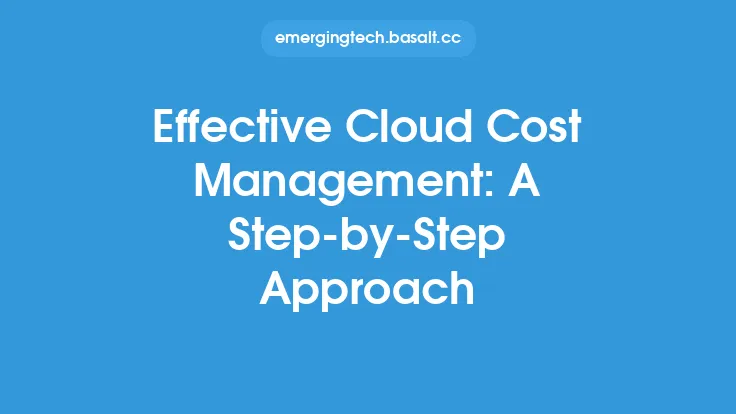As enterprises continue to adopt cloud computing, the need for effective cloud management strategies has become increasingly important. A well-planned cloud management approach can help organizations maximize the benefits of cloud computing, minimize risks, and ensure long-term success. In this article, we will explore the key considerations and best practices for developing a comprehensive cloud management strategy that supports enterprise IT goals.
Introduction to Cloud Management Strategies
Cloud management strategies are designed to help organizations optimize their cloud resources, ensure security and compliance, and improve overall efficiency. A good cloud management strategy should align with the organization's overall IT goals and objectives, and should be flexible enough to adapt to changing business needs. This involves understanding the organization's current cloud infrastructure, identifying areas for improvement, and developing a roadmap for future cloud adoption.
Assessing Cloud Maturity
Before developing a cloud management strategy, it's essential to assess the organization's current cloud maturity level. This involves evaluating the organization's cloud infrastructure, applications, and services, as well as its cloud governance, security, and compliance policies. The cloud maturity assessment should identify areas of strength and weakness, and provide a baseline for measuring future progress. This assessment can be done using various frameworks and tools, such as cloud maturity models, benchmarking studies, and cloud assessment surveys.
Developing a Cloud Management Framework
A cloud management framework provides a structured approach to cloud management, outlining the key components, processes, and policies required to manage cloud resources effectively. The framework should include components such as cloud governance, security, compliance, cost management, and service management. It should also define the roles and responsibilities of cloud management teams, and establish clear policies and procedures for cloud resource provisioning, deployment, and management.
Cloud Governance and Security
Cloud governance and security are critical components of a cloud management strategy. Cloud governance involves defining policies, procedures, and standards for cloud resource management, while cloud security involves protecting cloud resources from cyber threats and data breaches. A good cloud governance and security strategy should include components such as identity and access management, data encryption, network security, and compliance monitoring. It should also establish clear policies and procedures for incident response, disaster recovery, and business continuity.
Cost Management and Optimization
Cloud cost management and optimization are essential for ensuring that cloud resources are used efficiently and effectively. This involves monitoring cloud usage, identifying areas of waste and inefficiency, and optimizing cloud resource allocation to meet business needs. Cloud cost management tools and services can help organizations track cloud costs, identify cost-saving opportunities, and optimize cloud resource utilization. It's also important to establish clear policies and procedures for cloud cost management, including budgeting, forecasting, and chargeback mechanisms.
Service Management and Support
Cloud service management and support involve ensuring that cloud resources are available, reliable, and performing optimally. This includes monitoring cloud services, identifying and resolving issues, and providing support to cloud users. A good cloud service management strategy should include components such as service level management, incident management, problem management, and change management. It should also establish clear policies and procedures for cloud service support, including service desk operations, technical support, and training and development.
Cloud Skills and Training
Cloud skills and training are essential for ensuring that cloud management teams have the necessary skills and knowledge to manage cloud resources effectively. This involves providing training and development programs for cloud professionals, as well as establishing clear career paths and professional development opportunities. Cloud skills and training should include components such as cloud architecture, cloud engineering, cloud security, and cloud governance. It's also important to establish partnerships with cloud vendors, industry associations, and training providers to stay up-to-date with the latest cloud technologies and trends.
Cloud Management Tools and Services
Cloud management tools and services can help organizations manage cloud resources more effectively, providing features such as cloud monitoring, cloud security, cloud cost management, and cloud service management. Cloud management platforms can also provide a single pane of glass for managing multiple cloud environments, including public, private, and hybrid clouds. When selecting cloud management tools and services, it's essential to consider factors such as functionality, scalability, security, and support. It's also important to establish clear policies and procedures for cloud management tool selection, implementation, and management.
Conclusion
In conclusion, developing a comprehensive cloud management strategy is essential for ensuring the long-term success of enterprise IT. This involves assessing cloud maturity, developing a cloud management framework, and implementing cloud governance, security, cost management, service management, and cloud skills and training. Cloud management tools and services can also help organizations manage cloud resources more effectively, providing features such as cloud monitoring, cloud security, and cloud cost management. By following these best practices and considering the key components and processes outlined in this article, organizations can develop a cloud management strategy that supports their business goals and objectives, and ensures the effective management of cloud resources.





